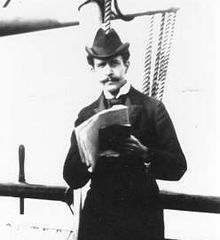Eugène Michel Antoniadi
Eugène Michel Antoniadi ( Greek Εὐγένιος Μιχαὴλ Αντωνιάδης , born March 10, 1870 in Constantinople ; † February 10, 1944 in Paris , also Eugène Michael Antoniadi or Eugenios Antoniadi) was a Greek astronomer born in the Ottoman Empire who lived in France for most of his life spent. He was best known for his excellent observations of the planets Mercury and Mars.
From architecture to astronomy
Antoniadi initially studied architecture and dealt with the Hagia Sophia , which he was one of the first to measure and scientifically investigate. Soon also interested in astronomy , he began various observations that were published through the mediation of Camille Flammarion and introduced him in 1891 in the Société astronomique de France .
At the age of 23, Antoniadi moved to France and became an observator at Flammariom's observatory in Juvisy-sur-Orge . After his observations on the large 24cm equatorial published in 1895 , he was accepted into the British Astronomical Association and entrusted with a solar eclipse expedition to Norway in the following year .
Masterful maps of Mars and Mercury
From 1898 the planet Mars and its Canali, discovered by Giovanni Schiaparelli in 1877 , became the focus of his observations. In contrast to his sponsor Flammarion, however, Antoniadi came across when he was working on the 83 cm giant telescope of the Paris Meudon Observatory during the Mars opposition of 1909 . He came to the conclusion that the " Mars channels " must be optical illusions that would only be visible as line structures in smaller telescopes . Over the next 20 years he made more and more detailed maps of Mars , on which he mapped the Canali through continuous rows of dark spots. His 4-part Carte de Mars , published in 1930, was the most accurate cartography of the "Red Planet" until the US space probes of the 1960s. . → More in the special article Mars canals .
Antoniadi also made a map of the planet Mercury , which was still very inaccurate due to the difficult observation of the planet using earth-based telescopes and was published in 1934. However, he made the erroneous assumption that Mercury has a bound rotation of 1: 1 when orbiting the sun . For the nomenclature of the albedo characteristics , he was based on the mythology of the god Hermes , the Greek equivalent of the Roman god Mercury. Audouin Dollfus adopted the names in his map from 1972. They are also used in current maps of the planet, which were created through exploration by space probes .
further activities
During longer-term observations of Saturn , he perceived radial, spoke-like structures in the Saturn rings . However, it has been dismissed by most astronomers as optical illusions , especially since Antoniadi's structures were supposed to move with the period of rotation of the planet and not the rings. It was not until 1981 that the existence of the spokes was confirmed by images taken by the Voyager 1 spacecraft .
To assess seeing (unrest in the air), he introduced a five-part scale (“ Antoniadi scale ”).
In 1925 he received the Jules Janssen Prize . A moon crater , a Mars crater and a surface structure on Mercury ( Antoniadi Dorsum ) were named in memory of Antoniadis .
Antoniadi was also a strong chess player . At a tournament in Paris in 1907, he finished unbeaten first place together with Frank Marshall , a full point ahead of Savielly Tartakower .
Fonts
- Ekphrasis tēs Hagias Sophias. 3 volumes. 1907-1909.
literature
- Stefan Heid : Eugenios Michael Antoniades . In: Stefan Heid, Martin Dennert (Hrsg.): Personal Lexicon for Christian Archeology. Researchers and personalities from the 16th to the 21st century . Schnell & Steiner, Regensburg 2012, ISBN 978-3-7954-2620-0 , Vol. 1, p. 88.
Web links
- Publications by EM Antoniadi in the Astrophysics Data System
- RJ McKim: The life and times of EM Antoniadi, 1870-1944. Journal of the British Astronomical Association, Vol. 103, No. 4, pp. 164-170 ( online ), No. 5, pp. 219-227 ( online ) (biography, English)
- J. Albertz, S. Gehrke, H. Lehmann: Topographical Maps of the Mars Surface , Berlin 2008 (PDF; 1.1 MB)
Individual evidence
- ↑ Cf. Stefan Heid: Eugenios Michael Antoniades . In: Stefan Heid, Martin Dennert (Hrsg.): Personal Lexicon for Christian Archeology. Researchers and personalities from the 16th to the 21st century. Schnell & Steiner, Regensburg 2012, ISBN 978-3-7954-2620-0 , Vol. 1, p. 88.
- ↑ G. Gerstbach 2003: Mars Channel Observations 1877–90, Compared with Modern Orbiter Data , PDF ( Memento of the original from July 14, 2015 in the Internet Archive ) Info: The archive link was automatically inserted and not yet checked. Please check the original and archive link according to the instructions and then remove this notice.
- Jump up ↑ 1909, map from Antoniadi
- ↑ MARS, Antoniadi Mars gazetteer, nssdcftp.gsfc.nasa.gov; Mariner 10 Advanced Image Search Arizona State Uni (accessed April 23, 2010)
- ↑ A Chessplaying Astronomer . Article by Edward Winter , 2002.
| personal data | |
|---|---|
| SURNAME | Antoniadi, Eugène Michel |
| ALTERNATIVE NAMES | Αντωνιάδης, Ευγένιος Μιχαήλ (Greek) |
| BRIEF DESCRIPTION | Greek astronomer |
| DATE OF BIRTH | March 10, 1870 |
| PLACE OF BIRTH | Constantinople |
| DATE OF DEATH | February 10, 1944 |
| Place of death | Paris |
